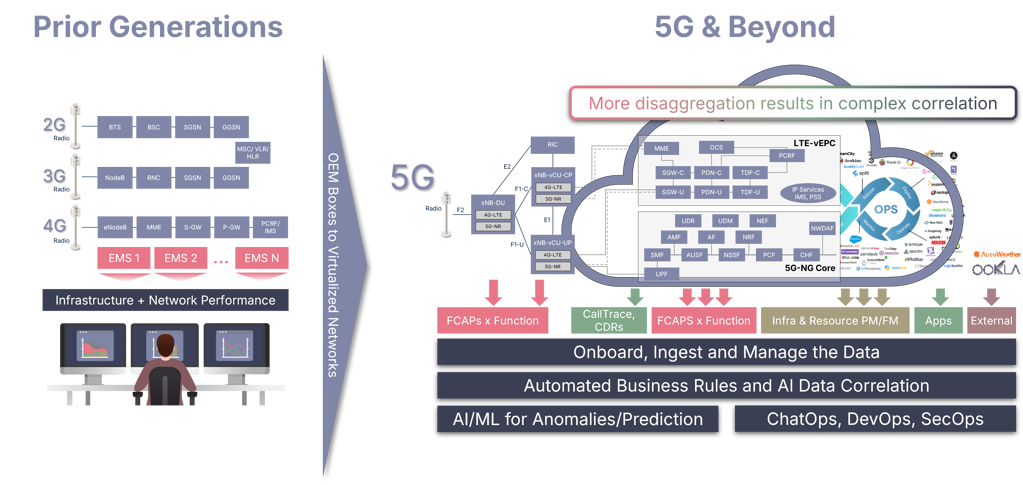Monitoring with Network Virtualization
Correlating the Complex for Event Driven Automation on Virtual Networks
5 Minute Read
Navigating the Future: Telecom Network Monitoring in the Age of Virtualization
The telecommunications industry has witnessed a remarkable evolution over the decades, transitioning from simple voice communication systems to the sophisticated, data-driven networks we rely on today. In this digital era, reliable service provision is paramount, making network monitoring a crucial component of telecom operations. Effective monitoring ensures the seamless delivery of services, identifies root-cause issues, and maintains optimal network performance, triggering event-driven automation. As mobile networks evolve, the industry embraces disaggregation and virtualization—concepts that decouple the hardware from software functions and transition services from traditional infrastructures to dynamic cloud-based solutions. This shift promises numerous benefits but introduces new network management and monitoring complexities correlating E2E services, underlying infrastructure, networks, and virtualized component performance.
Legacy telecom systems have predominantly relied on hardware boxes to deliver network services. These traditional setups used specific monitoring tools to track and analyze the performance and health of self-contained network component functions. Despite their effectiveness in simpler networking environments, these systems face significant limitations, particularly scalability, where adding new services requires physical hardware expansion. Additionally, the high costs associated with maintenance and upgrades and a lack of flexibility in adapting to new technological demands highlighted the urgent need for transformation in network management practices. Where core and networking functions have been the leaders in virtualization, virtualized RAN, whether traditional or OpenRAN, has driven mobile networks even further.
Introducing virtualized network functions marks a revolutionary leap in deploying and managing telecom services. Virtualization has enabled the migration of network functions to cloud environments (public and private), where scalability and resource allocation can occur dynamically. This shift provides operators increased flexibility, allowing them to scale services up or down based on demand and reduce the capital expenditure historically associated with physical hardware. The disaggregation of network functions—separating hardware from software—results in more agile networks that can quickly adapt to innovations, services, and market needs, embodying a more cost-effective and versatile approach to network management.
While virtualization offers numerous advantages, it also brings about new complexities in network monitoring. Maintaining comprehensive visibility and control over every element proves challenging with network functions dispersed across the cloud. The intricacies of performance management intensify as traditional, centralized control gives way to a distributed architecture. Furthermore, the transition heightens security concerns; protecting data integrity and ensuring robust cybersecurity becomes paramount in a virtualized landscape where data movement is constant and widespread. Telecom operators and their vendors' ability to address these challenges will bring the full potential of virtualization.

To navigate these complexities, adopting advanced monitoring tools and frameworks capable of providing deep insights into virtualized environments built on DevOps principles is necessary in addition to AI/ML, orchestration, and active inventory requirements. Leveraging AI and machine learning technologies can enhance data correlation and predictive analytics, enabling operators to anticipate issues before they impact service delivery. An orchestrated approach built on reliable active network inventory for resource management that adjusts dynamically to fluctuations in demand is essential for maintaining network efficiency. Close collaboration with cloud service providers and vendors also plays a crucial role, ensuring alignment in security protocols and performance expectations. By implementing these strategies, telecom operators can optimize their monitoring capabilities in a virtualized context.
Several telecom operators have successfully navigated the transition to virtualized network functions, serving as exemplars for the industry. These pioneers have capitalized on the inherent benefits of VNFs and developed innovative monitoring strategies to manage their networks effectively, highlighting the lack of existing solutions in the marketplace. The future of telecom network monitoring will continue to be further shaped by emerging technologies such as edge computing, AI workloads, and added IoT integrations, offering innovation and service delivery opportunities. In particular, edge computing with AI workloads promises reduced latency and improved bandwidth efficiency by processing data closer to the end user. As these technologies mature, the potential for further automation and intelligent decision-making within networks becomes increasingly viable. The advent of 5G and subsequent advancements will continue to drive network evolution, bringing unprecedented speed and connectivity and amplifying the need for sophisticated monitoring solutions to ensure optimal performance and security.
As the telecom industry evolves, the necessity for agile DevOps principles and effective network monitoring implementation must not be overlooked. The mobile networks' transformational journey from traditional hardware-bound setups to virtualized environments and the challenges and strategies associated with this shift requires new approaches. The imperative for telecom companies to adapt and innovate is clear, and embracing cutting-edge monitoring technologies will be key to future readiness and sustained success. Let us welcome the opportunities these advancements bring and strive for excellence in delivering uninterrupted, high-quality services to our communities.